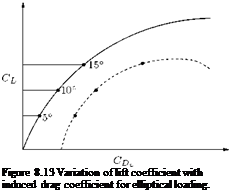Lift and Drag for Elliptical Loading
The lift coefficient for an aerofoil in terms of the circulation k0 around it, by Equation (8.6a), is:
nbk0
Cl —
The aspect ratio of the aerofoil is:
_ span 2b яі — — —
chord c
2b x 2b c x 2b _ 4b2
— ~y.
ко
4b
Thus, the lift coefficient in terms of constant downwash velocity, at the trailing edge, is:
![]()
 |
лЛію
U
By Equation (8.3), w/U = e and by Equation (8.25):
є = (a — a0).
Therefore:
By Equation (8.8), the induced drag coefficient is:
![]() C2
C2
Cl
nJR
The variation of Cl with CDv is called the polar curve of the aerofoil.
Equation (8.8) shows that the polar curve of an elliptically loaded aerofoil is a parabola, provided the only source of the drag is the induced velocity.
 |
The polar curve is as shown in Figure 8.13. The polar curve can be graduated in incidence as indicated in Figure 8.13. Since a is proportional to the lift coefficient Cl, equal increments of incidence gradients of the polar correspond to equal increment of Cl.
For incidence below the stall, the CL verses a curves are straight lines whose slopes increase as the aspect ratio increases, as shown in Figure 8.14.











